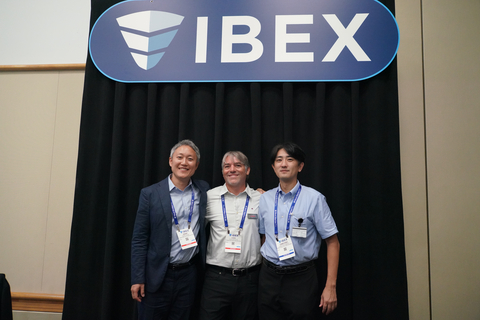
Yamaha Illuminates Hydrogen for Recreational Craft During 2024 IBEX®
Published by Todd Bush on October 18, 2024
KENNESAW, Ga.--(BUSINESS WIRE)--"Our work with hydrogen technology is a key part of Yamaha’s commitment to sustainability and innovation,” said Grant Suzuki, Yamaha U.S. Marine Business Unit Chief of Technology.
"By collaborating with industry leaders and advancing hydrogen propulsion systems, we’re not only exploring new possibilities for carbon-neutral marine products but also ensuring the performance and reliability Yamaha is known for remain uncompromised."

Grant Suzuki, Chief of Technology, Yamaha U.S. Marine Business Unit, Louis Doucette, Manager, Advanced Vehicles, Yamaha U.S. Marine Business Unit, and Tomoyoshi Onikata, Automotive Development Section, Yamaha Motor Company, dissected the challenges and opportunities related to hydrogen fuel storage, distribution infrastructure and regulatory requirements during IBEX 2024. (Photo: Business Wire)
>> In Other News: Vision RNG Secures $207 Million in Financing From Hasi to Construct Two LFG to RNG Projects in Ohio
Suzuki’s comments underscored “Hydrogen for Recreational Craft,” which Yamaha presented during the recent 2024 International BoatBuilders’ Exhibition (IBEX®).
The presentation included insights into Yamaha’s collaboration with leading industry partners, such as Roush and Regulator Marine, the long history of Yamaha’s efforts in hydrogen development, and the technical aspects of engineering a hydrogen internal combustion engine.
Along with Suzuki, Louis Doucette, Manager, Advanced Vehicles, and Tomoyoshi Onikata, Automotive Development Section, Yamaha Motor Company, dissected the challenges and opportunities related to hydrogen fuel storage, distribution infrastructure, and regulatory requirements.
The Yamaha team shared news of the company’s ongoing testing and development efforts. In early 2024, Yamaha introduced a hydrogen-powered golf car and a hydrogen-powered outboard (both industry firsts) as means to explore hydrogen as a possible method of achieving carbon neutrality within its product lines.
Yamaha has a long-standing commitment to exploring innovative and sustainable technologies, including hydrogen as a potential fuel source. The company's interest in hydrogen technology dates back to 2003 with early research into alternative energy solutions aimed at reducing environmental impact.
Over the years, Yamaha collaborated with various partners to develop hydrogen-powered engines. These efforts align with Yamaha's broader strategy to reduce carbon emissions and contribute to a more sustainable future.
By exploring hydrogen as a clean and renewable energy source, Yamaha is advancing environmental goals while maintaining performance and reliability.
Pursuit of hydrogen technology is just one example of Yamaha’s suite of multiple technology solutions to reduce carbon. Earlier this year, Yamaha acquired electric marine propulsion leader Torqeedo, expanding Yamaha's capabilities in electric and hybrid power.
In addition, Yamaha is actively researching and promoting the use of sustainable marine fuels as part of ongoing efforts toward carbon neutrality across the industry.
Yamaha U.S. Marine Business Unit, based in Kennesaw, Ga., markets and sells marine outboard motors ranging in size from 2.5 to 450 horsepower. It also engineers, manufactures, markets, and sells boat control systems, IoT control devices, fiberglass, jet-drive sport boats ranging from 19 to 27 feet, and personal watercraft.
The unit includes the manufacturing divisions of Yamaha Marine Systems Co., Inc., including Kracor of Milwaukee (rotational molding), Bennett Marine of Deerfield Beach, Fla. (trim tabs), and Yamaha Marine Precision Propellers of Indianapolis (stainless steel propellers). Yamaha U.S. Marine Business Unit is a division of Yamaha Motor Corporation, U.S.A., based in Cypress, Calif.
This document contains many of Yamaha's valuable trademarks. It may also contain trademarks belonging to other companies. Any references to other companies or their products are for identification purposes only and are not intended to be an endorsement.
REMEMBER to always observe all applicable boating laws. Never drink and drive. Dress properly with a USCG-approved personal floatation device and protective gear.
Subscribe to the newsletter
Daily decarbonization data and news delivered to your inbox
Follow the money flow of climate, technology, and energy investments to uncover new opportunities and jobs.
Latest issues
-
The Three-Continent Move That Redefines SAF
Wishing everyone a restful holiday season.🎄🎅🎁 Inside this Issue ✈️ Cathay Goes Global With SAF in Three-Continent Fuel Deal 🧪 Proton Ventures Partners With Barents Blue For Realization Of The Bar...
-
Can One Truck Fix Hydrogen’s Biggest Problem?
Inside This Issue 🚛 Alberta's Shared Truck Model Could Crack Hydrogen Adoption ✈️ ZeroAvia Completes Financing Round 🌾 Frontier And NULIFE Scale New Biowaste Carbon Removal Approach 🔥 WAGABOX® Of ...
-
North America’s Carbon Removal Year in Review: Winners, Losers, Surprises
Inside This Issue 🌎 North America's Carbon Removal Year in Review: The Deals, Policies, and Milestones That Shaped 2025 🚢 Hapag-Lloyd And North Sea Container Line Win ZEMBA Second E-Fuel Tender 🪨 ...
Company Announcements
-
ClimeFi Announces New 85,000 Tonne Procurement Round
In its latest procurement round, ClimeFi has enabled more than US$18m in durable carbon removal purchases across eight removal pathways: Biochar, Bioenergy with Carbon Capture and Storage (BECCS), ...
-
Vallourec, a world leader in premium seamless tubular solutions, and Geostock, a global specialist in underground storage of energy, have signed a Memorandum of Understanding (MoU) to strengthen th...
-
CMA CGM, DHL Step Up Ocean Freight Decarbonization with Biofuel Deal
DHL Global Forwarding and shipping group CMA CGM have agreed to jointly use 8,990 metric tons of second-generation biofuel to reduce emissions from ocean freight. The initiative is expected to cut...
-
Next-Generation Gas Turbine Control System For Thermal Power Plants Completes Functional Testing
Integration of Mitsubishi Power's control technology with Mitsubishi Electric's high-speed data processing technology Supports rapid load adjustments and diverse fuels including hydrogen Tokyo, ...